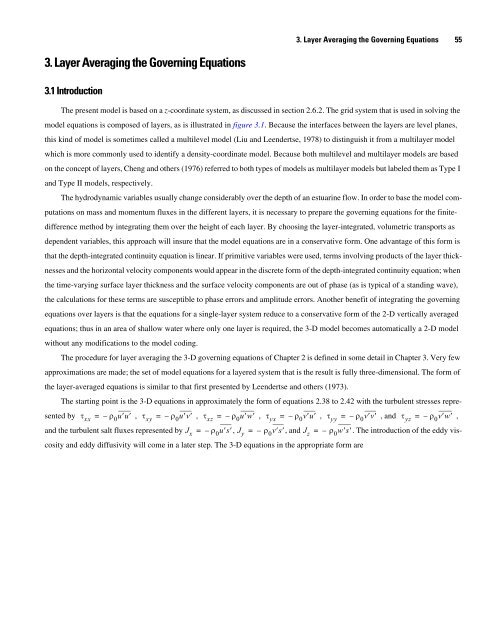A Semi-Implicit, Three-Dimensional Model for Estuarine ... - USGS
A Semi-Implicit, Three-Dimensional Model for Estuarine ... - USGS
A Semi-Implicit, Three-Dimensional Model for Estuarine ... - USGS
You also want an ePaper? Increase the reach of your titles
YUMPU automatically turns print PDFs into web optimized ePapers that Google loves.
3. Layer Averaging the Governing Equations<br />
3.1 Introduction<br />
3. Layer Averaging the Governing Equations 55<br />
The present model is based on a z-coordinate system, as discussed in section 2.6.2. The grid system that is used in solving the<br />
model equations is composed of layers, as is illustrated in figure 3.1. Because the interfaces between the layers are level planes,<br />
this kind of model is sometimes called a multilevel model (Liu and Leendertse, 1978) to distinguish it from a multilayer model<br />
which is more commonly used to identify a density-coordinate model. Because both multilevel and multilayer models are based<br />
on the concept of layers, Cheng and others (1976) referred to both types of models as multilayer models but labeled them as Type I<br />
and Type II models, respectively.<br />
The hydrodynamic variables usually change considerably over the depth of an estuarine flow. In order to base the model computations<br />
on mass and momentum fluxes in the different layers, it is necessary to prepare the governing equations <strong>for</strong> the finitedifference<br />
method by integrating them over the height of each layer. By choosing the layer-integrated, volumetric transports as<br />
dependent variables, this approach will insure that the model equations are in a conservative <strong>for</strong>m. One advantage of this <strong>for</strong>m is<br />
that the depth-integrated continuity equation is linear. If primitive variables were used, terms involving products of the layer thicknesses<br />
and the horizontal velocity components would appear in the discrete <strong>for</strong>m of the depth-integrated continuity equation; when<br />
the time-varying surface layer thickness and the surface velocity components are out of phase (as is typical of a standing wave),<br />
the calculations <strong>for</strong> these terms are susceptible to phase errors and amplitude errors. Another benefit of integrating the governing<br />
equations over layers is that the equations <strong>for</strong> a single-layer system reduce to a conservative <strong>for</strong>m of the 2-D vertically averaged<br />
equations; thus in an area of shallow water where only one layer is required, the 3-D model becomes automatically a 2-D model<br />
without any modifications to the model coding.<br />
The procedure <strong>for</strong> layer averaging the 3-D governing equations of Chapter 2 is defined in some detail in Chapter 3. Very few<br />
approximations are made; the set of model equations <strong>for</strong> a layered system that is the result is fully three-dimensional. The <strong>for</strong>m of<br />
the layer-averaged equations is similar to that first presented by Leendertse and others (1973).<br />
The starting point is the 3-D equations in approximately the <strong>for</strong>m of equations 2.38 to 2.42 with the turbulent stresses represented<br />
by τxx = – ρ0u′u′ , τxy = – ρ0u′v′ , τxz = – ρ0u′w′ , τyx = – ρ0v′u′ , τyy = – ρ0v′v′ , and τyz = – ρ0v′w′ ,<br />
and the turbulent salt fluxes represented by Jx = – ρ0u′s′ , Jy = – ρ0v′s′ , and Jz = – ρ0w′s′ . The introduction of the eddy viscosity<br />
and eddy diffusivity will come in a later step. The 3-D equations in the appropriate <strong>for</strong>m are

















